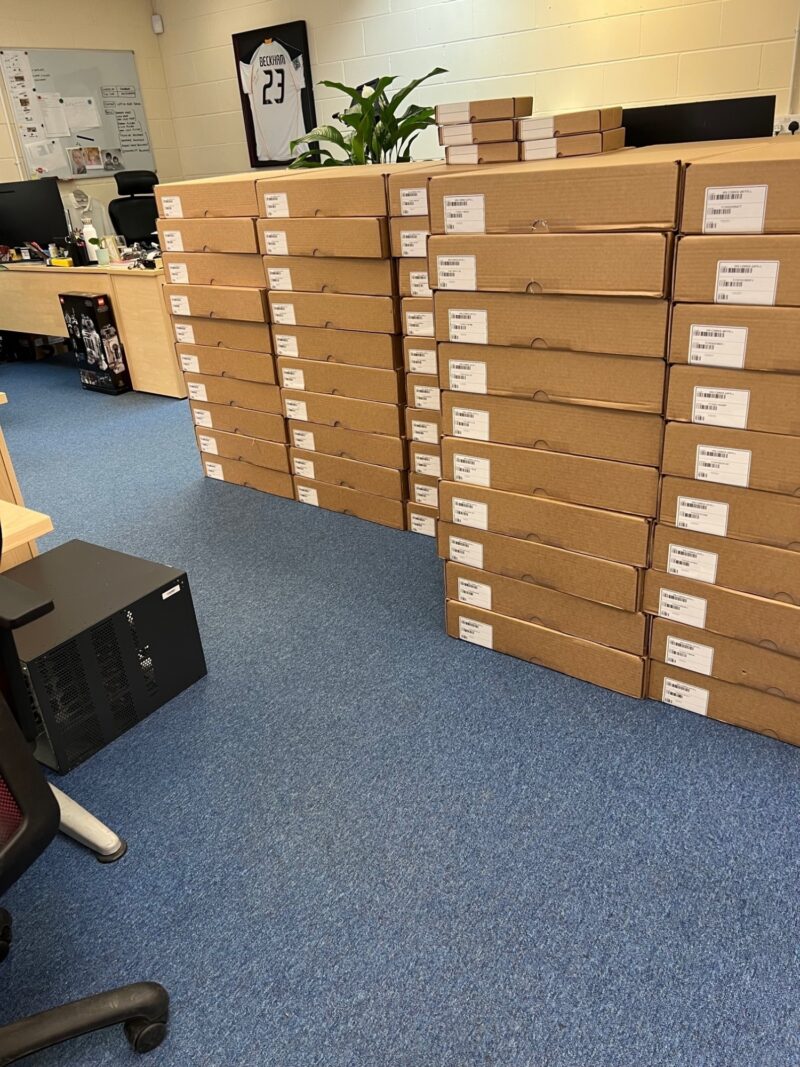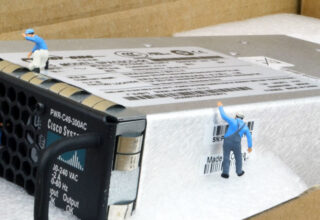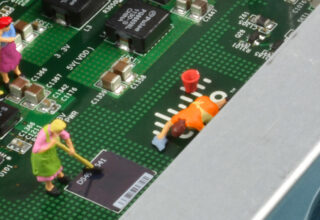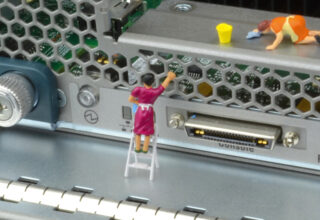CISCO Refurbished
- Manufacturer
- CISCO
- Condition
- Refurbished
- Lead Time
- 2-3 days
- Availability
- Not In Stock
- Price
- US$2,683.00 Enquire
Description
The BE6H-M5-K9 is a product offered by CISCO, a leading supplier of networking and communication solutions. This product is a powerful and reliable server designed specifically for the healthcare industry. It has been built to support electronic medical records, patient care applications, and other critical healthcare applications.The BE6H-M5-K9 offers high performance and scalability, which is essential in a fast-paced healthcare environment. It can accommodate multiple users and workloads, ensuring that critical information is always available to those who need it. The server includes advanced security features, including encryption and firewalls, to protect sensitive patient data.Moreover, the BE6H-M5-K9 is easy to deploy and manage. With its user-friendly interface and simplified installation process, healthcare IT professionals can quickly get the server up and running. The product is also highly customizable, allowing administrators to configure it according to their specific needs.Overall, the BE6H-M5-K9 server from CISCO is an excellent investment for healthcare organizations that need a powerful and reliable server to support their critical applications. It offers high performance, scalability, and security features, ensuring that patient data is always protected and readily available to those who need it.
Please note:
Includes Software, Drives, Processors, Memory - Fully Operational
- Part Code
- BE6H-M5-K9
- Description
- Cisco Business Edition 6000H (M5) Appliance, Export Restr SW
- Comments
- Includes Software, Drives, Processors, Memory - Fully Operational
- Manufacturer
- CISCO
- End of Hardware Support
- Yes (29 February 2028)
- End of Sale
- Yes (2 March 2023)
- End of Life
- Yes (1 December 2022)
Cisco DNA Center New Features for Release 1.3.3.0
Expand
Cisco DNA Center New Features for Release 1.3.3.0
Improved day-0 discovery of sensors with dedicated wireless backhaul and Secure Shell (SSH) support with Extensible Authentication Protocol – Transport Layer Security (EAP-TLS) support on wireless backhaul
Customers have the ability to standardize on the proactive sensor tests that they want to run across hundreds of sites that are part of the enterprise in a consistent fashion by leveraging sensor test templates and flexible scheduling capabilities
Sensors can now also simulate the guest onboarding experience in ISE
Once the tests are set up, customers now have the ability to centrally monitor them from the newly built heatmap-based sensor dashboard that can help pinpoint sites having problem and then drill down to specific locations where more client onboarding is failing or where there is poor RF coverage, using location heatmaps and Sensor 360
Enhancement to day-N sensor management use cases, including sensor status monitoring, SSH control with user name, LED flash control, name change with bulk change options, site hierarchy management, and support for bundle access for Cisco Technical Assistance Center (TAC) troubleshooting
View a summary of weekly and daily network and client health and application performance
View the comparison and change against the previous period
Analyze the number of network devices and clients seen on the network
View the top client types seen on the network
Analyze issue trends and top issues
The site-specific authorization template will enable customers to have a unique template for each site and continue to have a global authorization template
Critical VLAN will not be pushed by default via Cisco DNA Center templates.
Seamless authorization changes will provide granularity and allow the user to make authentication changes without removing the device from the fabric
Users can have different authentication templates based on the deployment model
If the ISE goes down, the customer will have the flexibility to choose not to immediately move all the clients into a single critical VLAN/pool.
Customers can onboard Internet of Things (IoT) devices, APs, and end devices with 802.1X and MAB authentication.
Devices connected to extended nodes can join scalable groups for secure onboarding. This feature will add value for customers who want to leverage micro segmentation.
Extended nodes will have multicast support. IoT devices such as surveillance devices can join multicast groups. The source and receiver can be hanging off of extended nodes.
Cisco DNA Assurance Features and Benefits
Expand
Cisco DNA Assurance Features and Benefits
Low and quantifiable CPU overhead
Optimized data export (key performance indicators [KPI], events)
Event-driven notifications
Run a path trace from source to destination to quickly get key performance statistics for each device along the network path
Identify access control lists (ACLs) that may be blocking or affecting the traffic flow
Rewind time to when the issue occurred
History shows critical events
All the information on the user or network device changes to the selected time
Intelligent issue detection and analysis
AI-driven personalized baselining: No two networks are the same. AI-driven technologies can learn the user trends, services, and application metrics that are specific to your network. Cisco DNA Assurance can then create a customized performance curve for analytical decisions. The AI-driven baseline for the performance parameters that are unique to your network is constantly adapted as your network grows and changes. From there, the AI-driven analytics engine (both on premises and in the Cisco cloud) can make accurate decisions for what is normal and what is not, based on this personalized baseline.
AI-driven anomaly detection: This capability surfaces any deviation from our AI-created personalized baseline for this network, allowing Cisco DNA Center to make sense of all the network data. The system can accurately detect performance issues and ignore unusual but harmless network anomalies. This reduces noise while accurately identifying anomalies that have the greatest impact on your network. AI-driven predictive analytics and proactive insights allow users to anticipate and prevent failures. Here, the machine learning engine can predict increases in Wi-Fi interference, onboarding delays, office traffic load, etc. This is because, in IP networks, a problematic event is often preceded by a benign event or series of events. By learning how series of events are correlated to one another, predictive analytics can help network administrators anticipate the unexpected.
AI-driven accelerated remediation: Cisco AI Network Analytics provides accelerated remediation through machine learning, which identifies the most critical variables related to the root cause of a given problem. This helps users detect issues and vulnerabilities, perform complex root cause analysis (using a machine reasoning engine), and execute corrective actions faster than ever. In coming releases, we will enable machine reasoning to execute the logical troubleshooting steps that an engineer would perform in order to resolve a problem. Both of these capabilities accelerate remediation, making your team more precise in problem solving and more productive overall.
The addition of an intelligent machine reasoning engine (MRE) allows for further intelligence in Cisco DNA Center. Included is the ability to discover Layer 2 spanning tree loops in your non-fabric (legacy Layer 2) network. Additionally, the MRE will scan current switch inventory for outdated images, PSIRT alerts, and suspicious configurations. These abilities are outlined further below under “AI Analytics Security Advisories.”
Supports per-device-group policies and analytics
Client details, such as iPhone model and iOS information
Provides insights into the client’s view of the network
Basic Service Set Identifier (BSSID)
Received Signal Strength Indicator (RSSI)
Channel number
Provides clarity regarding the reliability of connectivity
Client reasons, such as error codes for last disconnection
Correlated insights
Expand
Correlated insights
Association failures
Authentication failures
IP address failures
Client exclusion
Excessive onboarding time
Excessive authentication time
Excessive IP addressing time
AAA, DHCP reachability
Client experience
Throughput analysis
Roaming pattern analysis
Sticky client
Slow roaming
Excessive roaming
RF, roaming pattern
Dual-band clients prefer 2.4 GHz
Excessive interference
Apple iOS client disconnect
Network coverage and capacity
Coverage hole
AP license utilization
Client capacity
Radio utilization
Network device monitoring
Availability
Crash, AP join failure
High availability
CPU, memory
Flapping AP, hung radio
Power supply failures
Association failures
Authentication failures
IP address failures
Sensor exclusion
Excessive onboarding time
Excessive authentication time
Excessive IP addressing time
AAA, DHCP reachability
Sensor experience
Throughput analysis
Outlook web response time
Web server response time
SSH server response time
Mail server response time
FTP server response time
Excessive radio interference
High CPU
High memory
Routing technologies
BGP AS mismatch, flap
OSPF adjacency failure
Enhanced Interior Gateway Routing Protocol (EIGRP) adjacency failure
Connectivity
Interface high utilization
LAN connectivity down/flap
IP SLA to SP gateway connectivity
Client or device DHCP
Client or device DNS
Client authentication or authorization
Switch
CPU, memory, temperature
Line card
Modules
Power over Ethernet (PoE) power
Ternary Content-Addressable Memory (TCAM) table
Control plane reachability
Edge reachability
Border reachability
Routing protocol
MAP server
Data plane
Border and edge connectivity
Border node health
Access node health
Network services DHCP, DNS, AAA
Policy plane
ISE or pxGrid connectivity
Border node policy
Edge node policy
Client onboarding
Client or device DHCP
Client or device DNS
Client authentication or authorization
Switch
CPU, memory, temperature
Line card
Modules
PoE power
TCAM table
Cisco DNA Automation features and benefits
Expand
Cisco DNA Automation features and benefits
Cisco Discovery Protocol
Link Layer Discovery Protocol (LLDP) for endpoints
IP Device Tracking (IPDT) and ARP entries for host discovery
LLDP Media Endpoint Discovery (LLDP-MED) for discovering IP phones and some servers
Simple Network Management Protocol (SNMP) versions 2 and 3
https://www.cisco.com/c/en/us/td/docs/solutions/Enterprise/Plug-and-Play/solution/guidexml/b_pnp-solution-guide.html
Golden images: Intent-based network upgrades allow for image standardization, much desired by network administrators
Pre- and post-checks allow network administrators more control over and visibility into network upgrades
Patches are supported in Cisco DNA Center from intent to pre- and post-checks in the same way that we manage regular images
1. Configure network settings, service provider, and IP pools
2. Design a router or virtual profile
3. Assign to sites and provision network devices
Network profiles: A container of wireless properties that can represent single or multiple sites
Simplified guest and SSID creation
Advanced RF support for wireless networks
A single workflow to enable flex or centralized wireless deployment
PnP provisioning for APs
IP ACL support
Access and access control policy for SD-Access Wireless only
SD-Access Features and Description
Expand
SD-Access Features and Description
Fabric in a box without control plane
Bonjour support for Cisco SD-Access
Underlay and overlay correlation
Device health: Fabric border and edge, CPU, memory, temperature, line cards, modules, stacking, PoE power, TCAM
Data plane connectivity: Reachability to fabric border, edge, control plane, and DHCP, DNS, and AAA
Policy: Fabric border and edge policy, ISE and pxGrid connectivity
Client onboarding: Client and device DHCP and DNS, client authentication and authorization
Wireless guest support on separate guest border and control plane and wireless guest support as separate Virtual Network (VN) on enterprise border and control plane
Same SSID for traditional and fabric on same WLC (mixed mode)
WLC Stateful Switchover (SSO)
Wireless multicast
Multiple virtual networks for guest
Embedded wireless support on fabric edge
Guest web passthrough
Sleeping client timeout
ISE Primary Administration Node (PAN) High Availability (HA) support (includes pxGrid, Monitoring and Troubleshooting [M&T])
Distributed ISE Policy Service Node (PSN) support (two per site)
Same ISE instance for fabric and traditional (brownfield) deployments
Cisco Secure Access Control System (ACS) and ISE for TACACS+ authentication of network devices
HA support for Cisco DNA Center
Policy-protected Command-Line Interface (CLI) configuration
Software image and patch management
License management
Backup and restore
Task scheduler
Group-Based Access Control Policies
End-to-end policy and segmentation
Server connectivity for fabric edge
Support for up to six control plane nodes
LAN automation hardening
Cisco DNA Center template-based configurations in fabric deployments for key use cases
Border handoff enhancements: 4-byte ASN support
Two fabrics in a box at a site are supported without embedded wireless
Lan Automation support for Nexus 9500 as intermediate node but not as seed
Layer 2 flooding: Fabric support for end hosts that require Layer 2 flooding, for example, building management systems, audio-visual equipment, etc.
Catalyst 9500H series support for Layer 2 handoff
Up to 4000 scalable groups
Up to 500 access contracts
Up to 25,000 policies
System capabilities
Expand
System capabilities
Platform capabilities
Expand
Platform capabilities
Discovery, device inventory, network topology
SWIM, Plug and Play (PnP)
Template programmer, command runner
Assurance: Site, device, and client health monitoring, path trace
NFV provisioning
Fabric VN Limits (the current maximum VRF validation is based on a lower limit of 1 and an upper limit of 128, even if the device can support more than 128)
Expand
Fabric VN Limits (the current maximum VRF validation is based on a lower limit of 1 and an upper limit of 128, even if the device can support more than 128)
Role-based access control
Expand
Role-based access control
Refurbished CISCO BE6H-M5-K9 datasheet
Download PDF
Product datasheet - 1
Download PDF - 390.282 KB
Product datasheet - 2
Download PDF - 7.158 MB
Why Buy Refurbished?
Why Go Communications?
Related Products

UCS-MR-X16G1RS-H
16 GB DDR4-2666-MHz RDIMM/1R/x4
UCS-MR-X16G1RS-H
- Price:
- US$59.00
- Availability:
- Not In Stock
- Lead Time:
- 2-3 days

UCSC-RAID-M5
Cisco 12G Modular RAID controller with 2GB cache
UCSC-RAID-M5
- Price:
- US$267.00
- Availability:
- In Stock

UCSC-PSU1-770W
770W AC Hot-Plug Power Supply for 1U C-Series Rack Server
UCSC-PSU1-770W
- Price:
- US$89.00
- Availability:
- In Stock








